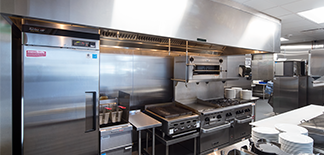It is important to understand grease extraction and new options in capturing grease particulate efficiently near the source.
A commonly overlooked by-product of many cooking processes is grease,—overlooked, that is, until it causes problems at your restaurant facility. To this day, even in lieu of research and new standards, the food service industry still struggles to understand grease extraction and options in capturing grease particulate efficiently near the source. It is understandable, however, because many filter manufacturers still claim that their filters are more than 90% efficient when in reality their actual efficiency maybe around 20- 30%. Why? These claims are based on a test developed by the U.S. Navy in 1974 (NBSIR 1974). This test was created before good methods of measuring particle size were readily available. Today, we know that particle size is one of the most important components of grease extraction efficiency.
How does this affect restaurant facilities?
Grease build-up in hood plenums, ductwork, exhaust fans , facility roofs, and adjacent equipment increase the risk of fire. It also can reduce the life of a fan due to wear on motors and bearings from uneven grease loading. Furthermore, grease may contribute to a costly reduction in the life of your roof because grease particulate can deteriorate roof lining membranes prematurely. Increasing operating costs in the form of duct cleaning and filter changes on adjacent equipment is also a side effect of poor grease particulate extraction. Lastly, exhausting particulate into the airstream outside of your facility can cause it to land on your customers' cars; easily turning a positive dining experience into a negative one. Neighboring businesses may also be affected by these airborne grease particles. The solution, which is more easily said than done, is to use more efficient grease filters near the source (kitchen hood) to mitigate grease deposits.
Understanding grease extraction efficiency
First, mechanical filtration, the method of filtration commonly used in commercial kitchen hoods, can only capture grease particulate (solids) and can not capture the vapor from cooking processes. Second, different cooking processes and cooking different foods have varying ratios of particulate to vapor generated during the cooking process as proven by ASHRAE study RP-745. A consortium of hood manufacturers, end- users, and other industry experts developed a standard method to test grease filter particle extraction efficiency.
Many years of research and testing resulted in what is now known as ASTM F2519-2005, a standard test method for determining grease particulate removal efficiency. This test method provides efficiency data that is illustrated in a graph as shown in this article. There are actually two data sets graphed and overlaid in the two figures. The first measures the size of the particle versus the mass of particles generated during a cooking process which was obtained from the ASHRAE RP-745 data.
Then a graph illustrating the filter efficiency versus a and bearings from uneven grease may contribute to a costly reduction in the life of your roof because grease particulate can deteriorate roof lining membranes prematurely. Increasing operating costs in the form of duct cleaning and filter changes on adjacent the risk of fire.
The area below the magenta line (squares) indicates the emissions produced during the cooking process. The area below the blue line (triangles) represents the grease that passed through the filter and into the rest of the system. The dark blue line (diamonds) illustrates the filter efficiency. As you can see, the first graph shows a baffle filter that has an inferior efficiency when compared to that of the dual stage filtration in graph 2.
Common types of mechanical filters
The most common filter used in commercial kitchen hoods is the baffle filter . This filter works on inertial force by turning the airstream back and forth once while traveling through the filters. This is one of the least efficient filter designs on the market. An alternative is centrifugal filters. Centrifugal filters spin the air in a corkscrew-like pattern through the filter using centrifugal force to push the grease out of the airstream. Providing middle-of-the-road efficiency, centrifugal filters are an excellent standard alternative to baffle filters. Another common method is multistage filtration. Multistage filtration uses a primary filter such as a baffle or centrifugal filter and a secondary filter with some type of media. The two stages together offer the most efficient mechanical filtration by capturing the smaller particles where other filters fail. Other types of filtration such as high velocity cartridge filters and water wash/ self cleaning hoods exist with varying efficiencies. See graph 3 for a filter efficiency comparison.
Making decisions easier
The ASTM F2519-2005 test standard provides the consumer with a way to objectively compare filter performance, much like the AMCA certification for fans. Not every manufacturer has taken it upon itself to test to this new standard. Consumers need to push manufacturers to provide sufficient test results that illustrate the performance of their filters. Do you always have to use the most efficient filter on the market? No. It is important to look at the application. If the cooking battery consists of light duty or lower heat equipment such as steamers, ranges, braising pans, etc., a mediocre filter will suffice. On the other hand, if the application has fryers, griddles and/ or char-broilers it would be advisable to choose a high efficiency filter. Generally, the hotter and faster the cooking process, the smaller the particles generated. Thus, better grease particulate removal efficiency is required.







